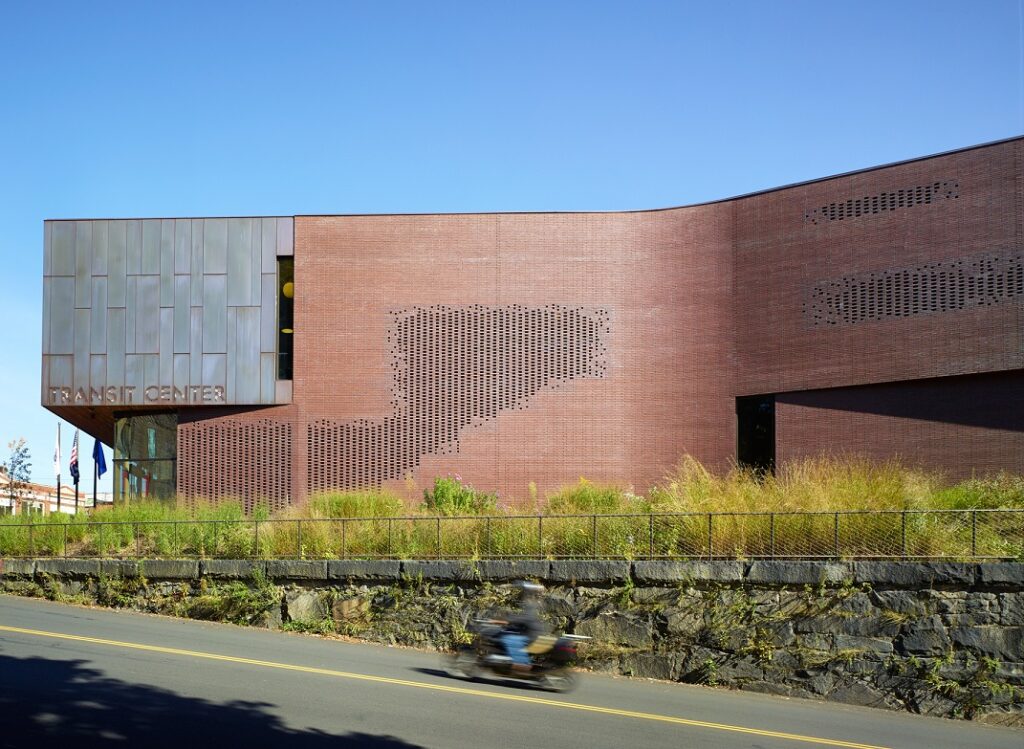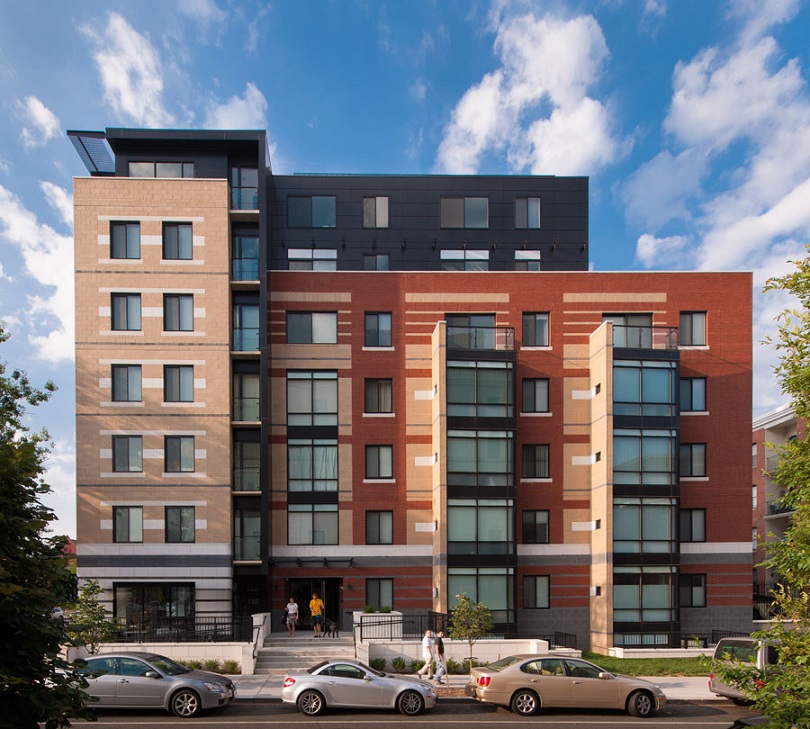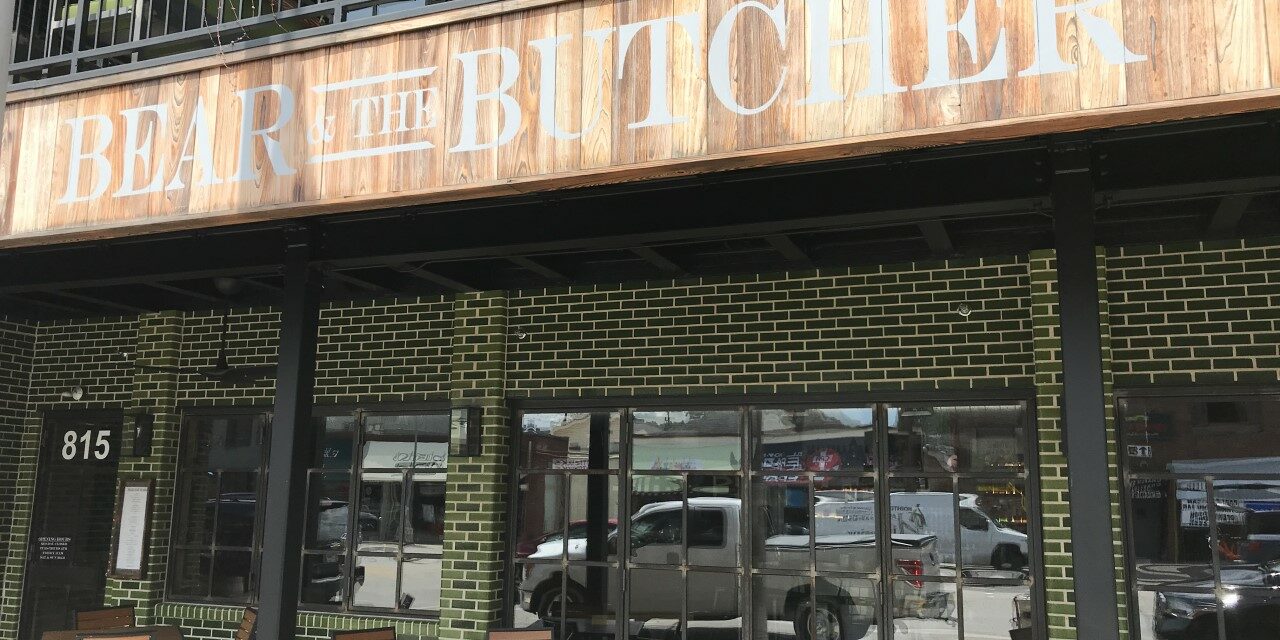Unique properties go beyond R-value to measure energy performance
While clay brick masonry veneer walls are widely known for their extreme durability, fire resistance and wide aesthetic options, their energy efficiency is less understood—especially since R-value is an incomplete measure of energy performance.
“Clay brick veneer is more energy efficient than people think,” said Stephen Sears, the Brick Industry Association’s (BIA) chief operating officer. “Recent research shows that brick veneer on wood stud wall reduces the amount of heat transfer through the wall up to 50 percent better than fiber cement, vinyl or even one inch of EIFS.”

John W. Olver Transit Center, Net-Zero Energy Building in Greenfield, Mass. 2017 Brick in Architecture Awards Best in Class Winner Municipal/Government Category. Photo credit: John Linden, Peter Vanderwarker
The top five unique factors of fired-clay brick that increase energy efficiency include:
- Thermal Mass (or thermal inertia): Thermal mass provides the ability to absorb and store heat thereby slowing heat movement through the wall. As a mass product, clay brick veneer acts similarly, storing a large quantity of heat before releasing it to the cooler side of the wall. This storage can reduce energy costs. The thermal lag, combined with a damping effect that reduces the amount of heat transferred, is why historic multi-wythe brick masonry buildings are often comfortable even without insulation in the walls. The delay in releasing energy means that the HVAC system will run less frequently and operate during off-peak hours when energy costs are lower. Thermal mass is most beneficial where there is a big difference between daytime and nighttime outdoor temperatures, especially in hot, dry climates.
- Air Space: The air space behind brick veneer serves as an insulating layer within the wall assembly. Even though the air space is connected to the outside via weeps, very little air actually moves within the space. Studies show that the amount of movement is negligible and can be attributed to the buoyancy of the air as it is heated—significant since it helps explain why the air space provides so much thermal benefit. Brick ties are often blamed for causing poor thermal performance, however, these ties are nearly undetectable by thermal imaging. The insulating and thermal storage properties of the brick and the air space typically outweigh the ties’ conduction.
- Fixed Temperature Performance: Energy efficiency is influenced by how the entire wall assembly—not the just the cladding material itself—reacts to temperature variations. Testing with fixed temperature conditions conducted by the National Brick Research Center (NBRC) confirm that heat takes two to three times as long to go through a brick wall assembly than it does others. It takes a brick veneer assembly nearly 24 hours to reach equilibrium, almost twice that of 1-inch thick EIFS and three times longer than vinyl or fiber cement siding. In a traditional day-night cycle of rising and falling temperatures, the heat flow changes direction before reaching the other side, resulting in less heat passing through the entire wall thickness. The brick wall’s heat storage capacity is twice the storage capacity of the brick alone.
- Varying Temperature Performance: An NBRC test with varying temperature conditions proves that brick walls reduce heat energy movement by 60 percent over the closest competing wall assembly. Unlike the static R-value, dynamic testing repeatedly cycles temperatures from low to high or vice versa, similar to rising and falling daytime and nighttime temperatures. When simulating an actual climate with a large temperature swing, brick veneer significantly outperforms other systems. In the summer, a brick veneer assembly reduces the amount of heat passing through the wall by approximately 50 percent over other wall systems. Regardless of the time of year, thermal mass has a much more profound impact on thermal performance than realized.
- Continuous Insulation Package: A standard brick veneer wall assembly is just one element to consider when enhancing energy efficiency. Area of windows, insulated glass and a well-detailed air barrier along with wall insulation all work together to boost interior comfort. A brick veneer wall assembly combined with continuous insulation is especially beneficial in cooler, northern climates. Increasing the size of the air space allows continuous insulation to supplement the insulation between the studs. A minor increase in the width of the foundation wall will permit including continuous insulation with no change to the building’s interior space or the exterior appearance.

The Aston – Washington, D.C. 2017 Brick in Architecture Awards Best in Class Winner Residential-Multifamily Category. Brick Manufacturers: Triangle Brick Co. and Carolina Ceramics Co. Photo credit: Maxwell Mackenzie
Brick veneer wall assemblies using brick with batt insulation and typical 2×4 or 2×6 wood stud framing meet the Residential Provisions of the 2018 International Energy Conservation Code (IECC) requirements for approximately 85 percent of the contiguous United States. For the remaining areas, generally located in cold, northern climate zones, the code requires some continuous insulation, which as mentioned earlier, is easily integrated into the air space behind the brick.
About the author
Brick Industry Association (BIA)
Founded in 1934, BIA at www.gobrick.com is the nationally recognized authority on clay brick construction representing the nation’s distributors and manufacturers of clay brick and suppliers of related products. Contact/Connect: Phone: 703-620-0010, Twitter @BrickIndustry, YouTube, Facebook, Instagram, and LinkedIn.




